PART 1. Research Methodology
[toc]
# Part 1 Executive Search Research Methodology
The executive search research process is divided into seven major steps.
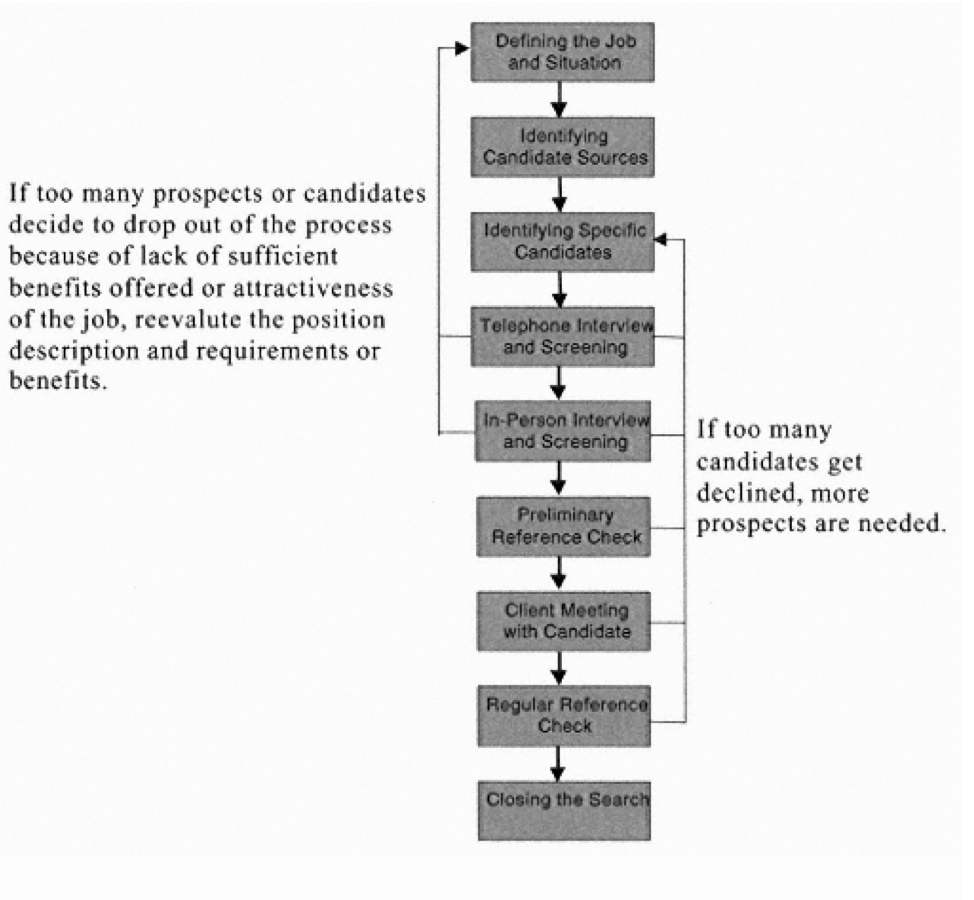
Basic Steps Documentation Created
> 基础定义,及输出
**1. Defining the job.**
职位定义:与客户确定职位画像,要什么人?
输出文档:
- 公司概况
- 职位概况
- 其他信息
Situation Analysis. Meeting of minds between client and consultant regarding what they are looking for.
*A written document, the position specification describing the full picture-company, position, and requirements. At the same time a template with only the requirements is made, which is later used for screening.*
**2. Identifying candidate sources.**
确定候选人池:寻访计划,从哪里找人。
Making a task plan regarding the time frame for the search, where to look for the right candidate, selecting industries, what companies to look into, and what individuals to speak with.
*An alphabetic target list with the names of companies and people you are going to source. The list should be sorted according to company, and alphabetized according to potential candidates' last names. In this format, the calling list can be utilized as a log.*
**3. Identifying specific candidates.**
识别具体候选人
The process of identifying potential candidates is called sourcing, which is best accomplished by speaking to key people who are in the target group and asking them for assistance.
*During sourcing, the comments made by the people being contacted should be recorded in the log, with dates and correct code. This means if a source, for example, becomes a candidate, the coding and group that this particular individual belongs to will change.*
**4. Telephone interview and screening.**
电话面试,或者现场面试候选人
Interviewing potential prospects on the telephone and obtainin necessary information to decide whether they remain on the list. If the candidates remain on the list, begin gathering more information。
*Use the template you made in Step 1 and compare it with the prospect's background. It is also helpful to have prospective candidates explain to you how they feel their background fits your position specifications. If it is still not clear whether the prospects are on target, then you can go through the template with them over the phone. These notes should be stapled to the rsum*
**5. In-person interview and screening.**
面试候选人
Verification of facts concerning a candidate by face-to-face interview. Getting a sense of the personality. Finding out more about the candidate through questions and your own judgment to determine whether the person fits and moves to the next level.
*Those candidates who are on target should be written up in an extensive report describing personal traits, work history, and personal observations made by the interviewer. The documentation regarding the work history is called a career brief. The documentation portraying a more personal picture of the candidate is called the appraisal. This document seeks to explain where the person is coming from, why certain choices were made in life, strengths and weaknesses, and the interviewer's assessment.*
**6. Preliminary and regular reference check.**
背景调查
Preliminary checking of a candidate is conducted before the client interview by discreetly speaking to a few people for an insider idea of the person. A regular reference check is conducted after the client interview. At this stage, there is extensive questioning of several people whom the candidate is working or has worked for.
*The questions being asked during the regular reference check are basically the same for everyone. All the replies from the references are recorded, as stated, in a reference report.*
**7. Closing the search (closeout).**
完成寻访
After a successful placement of the candidate, all sources and unsuccessful candidates are contacted to tie up the loose ends. All the necessary documentation is placed in the closing file.
*The various people that you have closely interacted with during the search get a letter stating the appreciation for their time and/or interest in the search or position. These acknowledgment letters are called closeout letters.*
## 1. Defining the Job
> 职位定位、职位描述。职位说明书。
(1) the person leaving the position;
(2) the person that the new employee will report to;
(3) coworkers; and
(4) people reporting to the new employee.
By gathering the necessary information from these four groups, you ensure that the picture of the situation is accurate.
The job description is a written document that should be extensive enough to give potential sources and candidates a **clear and informative picture of the company**, the position to be filled, and the requirements.
Written documentation is a tool for everyone in the process: the company with the recruitment need, the consultant and researcher (if you are using outside help), the client, sources, and potential candidates. It is very important to conduct sufficient research so that you are able to write the documentation, answer questions from sources and candidates, and conduct an extensive search in the market.
Keep in mind that even though you might know all the answers to the different topics, you still have to cover everything. The first documentation, which is based on the following required information, is called situation report documentation。
**The Company**
- Historical background, development
- Plant and office locations, affiliations, number of employees
- Organizational structure (organization chart)
- Product lines, sales volume, market share
- Profitability; past, current, and projected rate of growth
- Strengths and weaknesses of the company
- What is the company culture like?
- Why has the vacancy arisen?
- If a person was previously in this position, where did he or she go
- What background did this person have
- Why has the position not been filled internally?
Is there something unusual about this position?
What efforts have been made to fill the position and why have they failed?
**The Position**
* Title of position
* Responsibilities, functions, duties, and accountabilities
* Objectives and time frames in which to achieve them
* Organization charts of whole company and relevant department or division (showing functional as well as hierarchical relationships)
* The challenge and attractions of the job (including compensation package)
* What company policies and practices will affect the jobholder?
* What are the personalities of the people with whom the jobholder will be in contact?
* What are the future opportunities for the person appointed, and over what time scale?
* Supervisor and subordinates and their qualifications and experience
* Geographic restraints
* The Ideal Candidate (Identify the ideal candidate's qualities on two levels: essential and desirable)
* Education and paper qualifications
* Experience
* Language requirements
* Personal qualities
* Skills required
* What type of company culture would you expect the person to come from (or not to come from)?
* Target Companies and Positions: Where Might This Person Be Found?
* Names and divisions of companies
* Geographic locations
* Sales volume
* Standard Industrial Classification (SIC) and function codes
* Number of employees
* Possible title(s)
* Possible level(s)

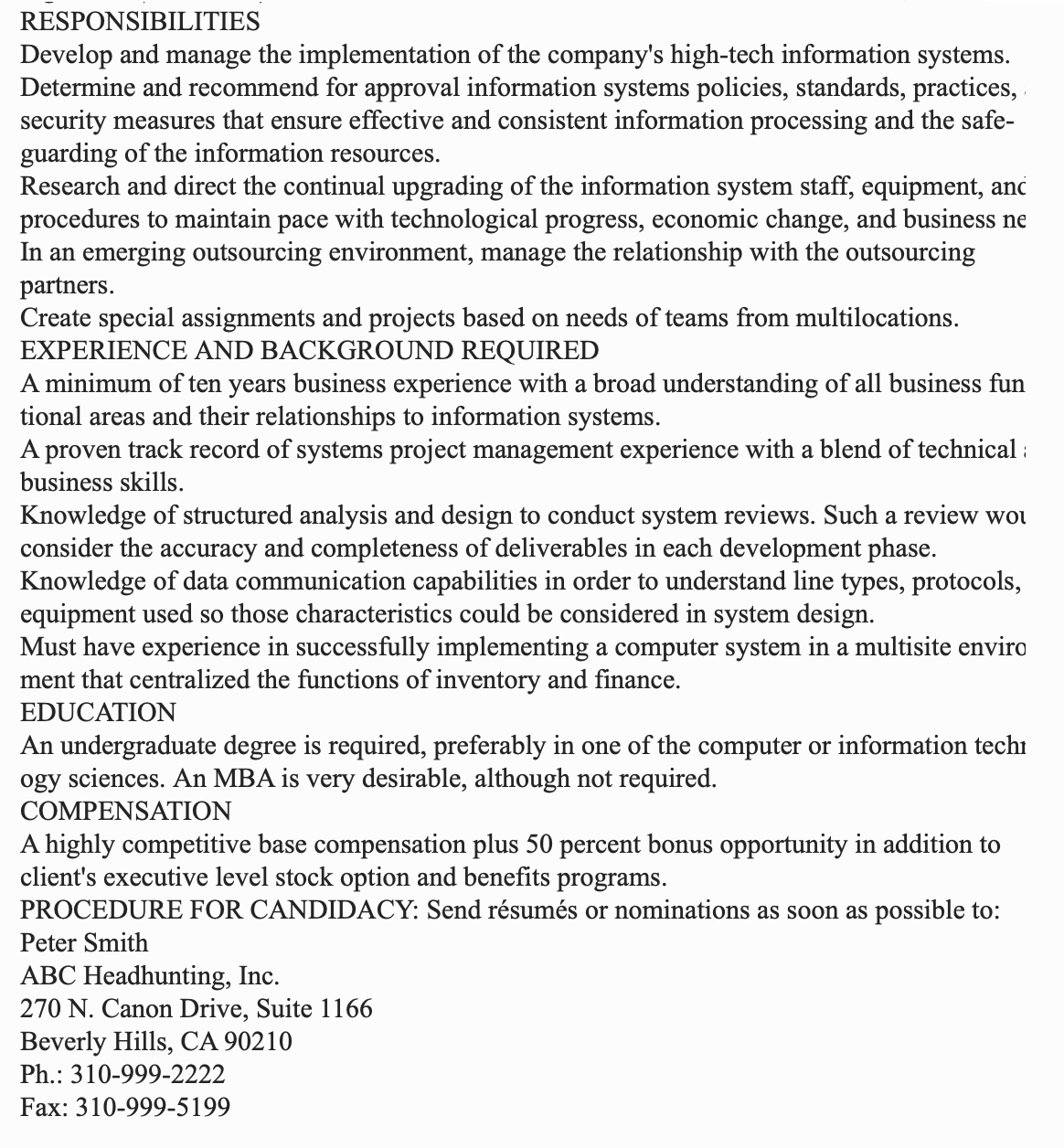
## 2. Identifying the Candidate Sources
> 寻访计划
It is important to prepare a formal task plan to guide yourself through the search for Mr. or Ms. Right.
Most task plans consist of at least four major elements:
1. Selecting likely industrie
2. Identifying target companies
3. Sourcing for specific individuals
4. Time schedule
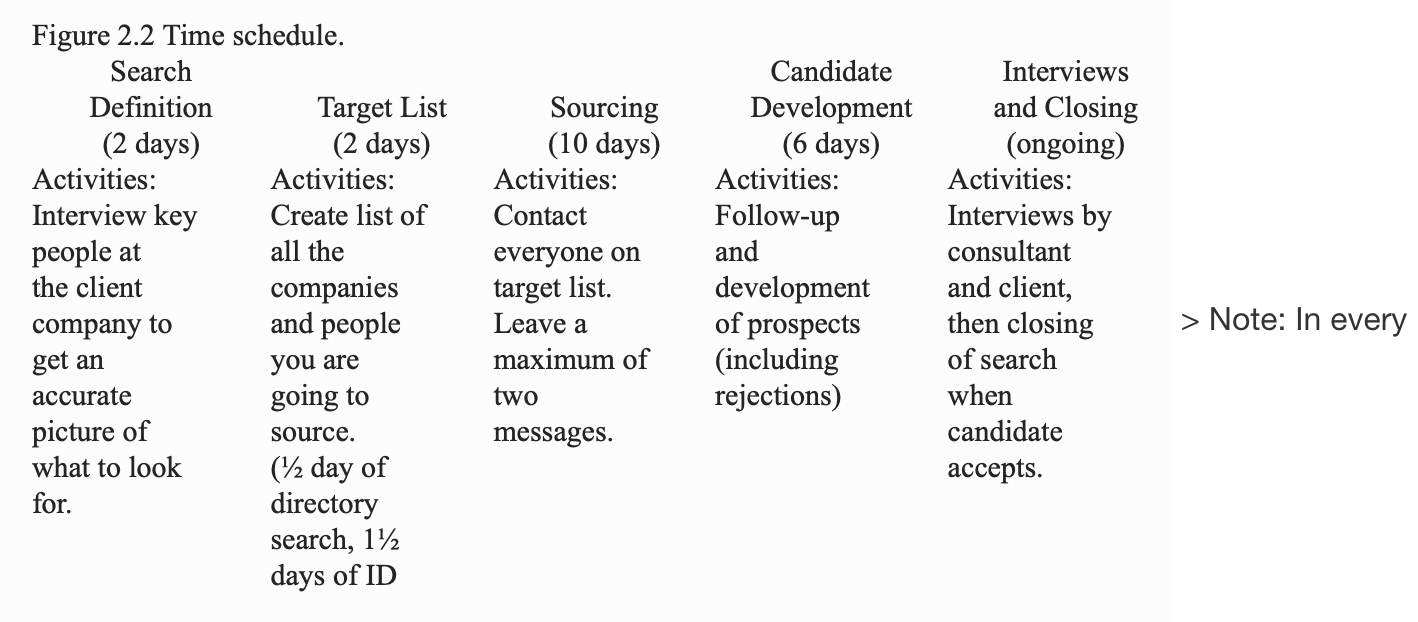
> Note: In every search it is important to work backward from the completion date. This means that if you are using an external executive search consultant and he or she has promised that you will be presented with a candidate four weeks after the start of the search, the executive search consultant should meet that person at the latest three days before that date. This in turn means that the individual must have been identified and fully developed seven days earlier (telephone interview before the face-to-face interview). In order to meet this goal you must have approached all the people on the target list at least once in less than two weeks from the start of the search. “ Only in the first parts of the search do you have full control over time and process. It is harder to control the activity that goes on after the prospect has been interviewed face-to-face, because this is when the major decisions for both parties have to be made. It is always difficult to predict how much time people need to think things over, and how many people you need to see before you make a decision. Also, the negotiations between your company and the candidate regarding terms can sometimes be lengthy.
## 3. Identifying Specific Candidates
> 确定具象候选人
The first place you should start looking is in your file of previous searches. These sources may identify as many as several hundred potential candidates.
### 3.1 Sourcing
Sourcing is the process of locating names of possible candidates by referral from others (or themselves, when contacted).
#### 3.2 Finding Sources who left the Company
> 寻访的两个小TIPS
1. Cross-check directories.
Look at the executives listed in a current directory, and compare them with those listed in an earlier edition of the same directory. Names that were previously listed but are not in the newest edition are good potential sources.
Next, phone the company and ask for the missing people. Pretend that you think they are still there. Tell the switchboard operator or the person in the department that you are speaking to that you used to be friends with the person, but you lost touch over the years.
Keep in mind that if you get the HR department on the line the game is over, because they generally will not give out a forwarding number.
1. Connect with someone in the department that you are targeting.
Tell the person at your target company that you are looking for someone that you met a while back who had told you he used to work with the target company until recently, but had recently started elsewhere. If he or she asks you why you want to know, say that it is very personal and out of respect for the person in question you do not wish to disclose any further information on the matter. You are not 100 percent sure about the name, but you think that it may be Jim or Peter. In most cases the person will try to help you out by giving you different names of people who have left if you just keep probing. This method should only be used if nothing else works. You should always use your real name and the company that you are calling from, if you are asked. Never pretend that you are someone else as you can get involved in legal complications. Be persistent, polite, quick, and positive.
#### 3.3 Mailings and Source Letters
> 邮件的威力
Mailing the position specification to potential sources and candidates is a practice that both private companies and several executive search firms stick to religiously, while others ban it.
Even some of the most prestigious executive search firms with top-notch positions do mail-outs. To obtain the best possible results, certain basic rules should be followed
1. Protect the confidentiality of the firm. The company name should be left out if possible (this is of course difficult if the company with the recruitment need is conducting the mailing). If the recruitment is official, the position specification can be very detailed. If the opposite is the case, then you need to be careful about what information you present, as you do not want anybody to be able to guess what company it is. This confidentiality can only be ensured if an external executive search firm is conducting the mail-out.
2. The source letter must be well written. Get to the point quickly, and stick to the basics. Be sure that there are no grammatical errors in the letter. Mistakes indicate sloppiness and give an adverse impression about you, the sender. Every source letter must be addressed to the receivers as sources. If you plan to mail a position specification to somebody at his or her workplace, be aware that the mail will likely be opened by a secretary or assistant before it reaches the target. This means that you cannot afford any misunderstandings. Even though you try to reach a target that you feel could be a great candidate, still write to him as a source. If you already have spoken to somebody who has shown great interest and wants to receive the mail at home, you can use a so-called potential candidate letter. Keep in mind that this kind of letter can never be sent to someone's work address.
3. The receivers of the mail-out are all the people on your target list. Each mailing (envelope) should contain a source letter and a position specification.
4. Never wait for your target group to call you. Right after the creation of the target list and the mail-out, start calling. You can never afford the luxury of waiting for the mail to reach the targets.
Note: Do not call anybody before you have created the target list. It will, to a great extent, slow the process later in the search if you have to stop because you did not make a complete list in the beginning.
### The Proposition (陈述)
Before making any calls, it is important to make sure that** you can do a good job selling both the job and the company. **You must practice to the extent that you can do the pitch well and at the same time sound convincing. **Do not start calling before you have it down right, as you get only one chance to make a first impression.**
**A good way to make sure that you get the pitch right is to write down what you want to say and practice it until you know it by heart.**It will also be of great help to have this script next to you when you are working on several searches simultaneously. Let someone who is also working on the search listen to your sales pitch before you start making calls. This will help ensure that what you are saying is correct.
When making the pitch, do not trick your target by lying, just to get him on your hook. If you do so, it will only backfire later in the process. Put yourself in the shoes of the listener. **Be able to explain why your listener should be interested in the opportunity. You must be able to sell the position, which means finding a good way to trigger the listener's attention.** Keep in mind that any negative points may cause the target to decide too rapidly against what may actually be a very good opportunity.
**Before you start to make calls, it is helpful to speak to someone who really knows the field for which you are recruiting.** Preferably, this person should not be a candidate, as you want to determine the golden nuggets that will make someone interested in what you have to offer. Also, try to practice your pitch with this expert so you can get some feedback and make necessary adjustments
### Direct Telephone Contact (Some Rules)
> CC 相关
keep in mind that these people probably get a lot of calls from people like you.So you have to grab their attention quickly. When you speak, be as positive as possible about the assignment. Keep in mind that attitude is as important as presentation. The opening dialog could contain the following information:
* Name
* Executive search consultant or in charge of recruitment at Company X
* Currently looking for a director of manufacturing
* Build up a personal relationship in the first few sentences
* Be short and direct; don't waste the candidate's time with explanations.
* Be aware that you have something to offer.
After the pitch, ask if the person would like to hear more, based on the brief information. If you feel that the person could be a candidate, mention to her that she has been highly recommended, which is why you are calling. Keep in mind that most people like to be flattered.
This should be done by calling her at home after work. If she appears to be on target and is open to listening, keep in mind that most candidates will not say yes in the first three minutes of the conversation, as switching jobs is not like buying dinner. As this is the starting point of a relationship, you have to be the prospect's friend throughout the process. With this attitude, you will be well respected even by the ones you reject.
问题集合:
* “Do you know anyone who might be qualified and interested in something like this?”
* “Is this an opportunity that would be appropriate for someone with your background?"
* "Would you be interested in learning more about this opportunity?"
* "The next step would be for us to get some information on your background. Can we do that while we're on the phone right now?”
**Repeat anything that is not clear.** Try the statement, "My understanding of what you are saying is." or "Am I understanding you correctly when you say?" Very often the person you are speaking to might not have a résumé. If such is the case, ask him or her to prepare one. At the same time, keep in mind that the best way to get the information you need accurately and quickly is to get it over the phone. This is typically the best way to sketch someone's background.
you need to know where in the organization they stand.You should ask your prospect for the titles of:
* His or her boss
* The boss's boss
* All direct reports and the number of people reporting to each of them
* Peers reporting to the same boss
If a candidate is not interested in the opportunity you present, always find out why. It may be something that can be dispelled. If not, source him for other potential candidates. If neither, leave your name and telephone number always try if possible to get information on him or her for future reference. No matter what the outcome is, always be polite.
### Documentation (Recording Information) 电话备注
When searching for the right candidate, you will deal with many telephone calls and with a lot of information pertaining to each call. To make sure that you are in full control of the situation, be sure to write everything down, including information such as:
* Person to speak to (full name, address at work and home, telephone numbers, title, company)
* Details of the conversation, with time and date
* When to follow up again, with time and date
* What category the contact is
The main purpose behind putting everything in writing is to make things easier for yourself and at the same time enable you to make maximum use of the information that you gather. You must therefore not only write down everything of importance, but also organize it so you can easily retrieve what you need.
## 4. Interviewing and Screening 面试CM
When calling potential prospects, it is of great importance to be able to screen people, to separate the gold from the silver. It is very important to be good at screening, so that you avoid wasting your own time and, of course, the time of the people that you contact.
There are basically two different screenings or telephone interviews that take place when you hook up with someone who could be the right one:
1. The first interview, called basic screening, is conducted when you want to figure out if someone is a fit. This is when you are using a template.
2. The second telephone interview, called *development of a potential candidate*, is conducted after you have decided that someone appears to be on target, but you need more complete background information in order to have an accurate picture. It also enables you to get right to the questions and the essence of the candidate when later interviewing this person.
there will always be people you need to question by phone in order to screen them. In some cases you will even deal with people who are afraid to submit a résumé (even if they are very interested). When this is the case, you just have to get everything you need over the phone so you can create your own complete résumé on the prospect. During the telephone interview process you always need to ask the same questions, so it is very helpful to use the template.
**Candidate Development**
By obtaining every piece of background information before meeting someone, you will find it easier to spot the weak spots or potential gaps in the career history or moves that appear to be happening. You can and should, basically, by having someone "developed" before the meeting, be able to cut to the meat.
Checklist for Candidate Development
__ Education and work experience, dates with gaps reconciled
__ Succinct organization descriptionswhat business, scale for each company
__ Position titles
__ Organizational chart (above, on line, and below)/reporting relationship
__ Size of the department, division, or group responsible for
Position responsibilities
__ At least three major accomplishments in each position
__ Motives for interest in position
__ Reasons for job change
__ Personality
__ Compensation; age
__ Thoughts on why this prospect might be a good candidate
__ Accomplishments relating to the specific responsibilities enumerated in the spec
__ Details of source(s) by whom mentioned
__ Level of interest and obstacles
**The Face-to-Face Interview** CM
**面试准备**
In order to be a successful interviewer and thereby get the results that you want, you need to:
* Be well prepared (study the write-up and comments that you earlier obtained over the telephone).
* Know what questions to ask (know what you need to probe on), and do not be afraid to ask them.
* Have a very good understanding of what your company's needs are.
* Understand the personalities of the people with whom the candidate will be working
**面试中**
During the entire interview, let the candidate do most of the talking. Try to stick to the 80/20 rule; ask questions 20 percent of the time and you will be able to listen 80 percent of the time. It is very important to know in advance what you are going to say and ask, because this enables you to dedicate the greater part of your time to listening. Always use the assessment report。
After some social chatting, it is important to figure out what the candidate was like through high school and college and what events in the candidate's youth might have shaped his or her career. Also attempt to cover the different personal events during the candidate's career, such as a divorce or health problems, and of course areas of interest at the present time. If the client likes to go mountain climbing, it is nice to have a candidate who also enjoys mountain climbing.
**如何面试**
During the interview, look constantly for personal impressions such as posture, self-assurance, presence, enthusiasm, ego, aggressiveness,ability to get to the point quickly, ability to articulate accomplishments, memory, quick mind, personality, sense of humor, and other traits. Good questions to ask are: How would your present boss describe you? Are there any personal factors that could affect your employment? When conducting the interview you can never be lazy about making notes. Another important rule is to try to stick to open-end questions (unless you want to clarify whether the candidate has certain skills or background required for the position, which can be answered with yes or no). When you ask questions, do not show signs of agreement. To get the most out of the time, do not comment at all. Just listen very carefully, and ask the right questions. (Remember that in some cultures, it is illegal to ask certain questionscheck this out for the country in which you are interviewing people.)
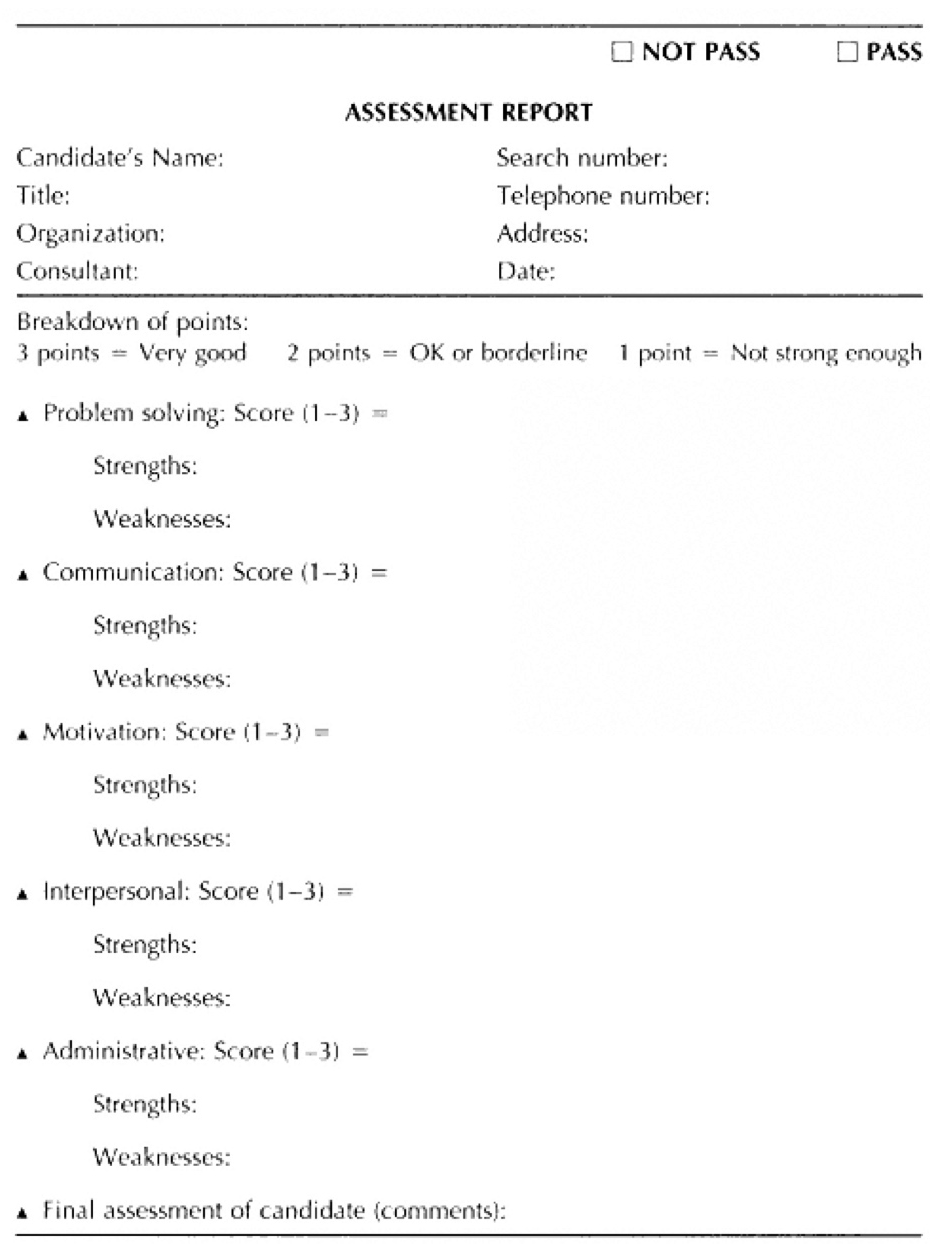
Basically five different areas need to be covered in the interview. They are:
1. Problem-solving skills
2. Communication skills
3. Motivation
4. Interpersonal skills
5. Administrative skills
After the interview, you should be able to answer the three crucial questions:
1. Is the candidate able to do the job?
2. Is the candidate willing to do the job?
3. Is the candidate going to be manageable?
**关注时间**
* Never try to make a marathon session out of the meeting.
* Do not chit-chat more than necessary.
* Spend a maximum of ten minutes to break the ice.
* Always get to the point when you speak.
* Keep in mind that you are in charge. To make sure that you cover everything, you need to tell the candidate up front how many minutes you have available and what you need to cover. (The meeting should last from one to two hoursmaximum.)
**Documentation you should bring to the Interview**
> 需要准备的文件
__ The candidate's résumé with notes from the development.
__ A list of comments and initial questions based on telephone contact and the résumé. You should know what specific areas you need to probe in order to feel that you have a complete picture of the candidate.
__ A list of interview questions (the list in this chapter can be used as a guideline).
Immediately after the interview, while everything is still fresh, you should prepare the assessment report. This report is basically a one-page summary of the interview, where you list the strengths and weaknesses
> 面试结束之后,应及时完成面试总结,包括你对候选人优势和劣势的判断。也是你认为该候选人为何适合的判断。
**Sample Interview Questions**
General Start-up Questions
1. Draw the organizational chart of your present company, including your specific department. What is your role
2. What indicators measure your performance within your current position?
Approaches to Problem Resolution
1. Were you ever in a situation where you had too many things to do in the time available? How did you handle it?
2. What kinds of decisions are most difficult for you?
3. Do you discuss important decisions with anyone?
4. Imagine a situation where you find yourself without the specific technical knowledge to perform a task essential to a project. What would you do?
5. Imagine you are asked to set up a task force to investigate the advantages of using temporary office workers in your company. If there were no precedent for establishing such a task force, how would you do it?
6. If you had to interview someone for a position on your staff, and you lacked the technical depth to understand their competence, how would you handle the interview?
7. What major problems have you identified in your current position that were previously overlooked, and what have you done about it?
8. What kind of people do you feel represent a challenge to work with and how do you best deal with them?
9. What was your biggest challenge this last year at work, and how did you reach a solution?
10. What was your worst mistake during the last year, and what did you do about it。
“What has been the toughest decision you have made in your career?
1. In terms of problem resolution would you describe yourself to be more analytical or intuitive? Give specific examples.
2. How do you react if someone criticizes the work you have done? Give specific examples.
3. What notable successes have you had in problem solving for your company?
**Communication Skills**
1. How would your boss describe you?
2. How would your closest friends and family describe you?
3. How would you describe yourself in terms of weaknesses and strengths?
4. In considering important career questions, what impact does your closest family play in the decision making?
5. What do you do for relaxation, or what means a lot to you, besides work?
6. If you could start again, what would you do differently?
7. Do you consider yourself to be more or less creative than your boss and coworkers? Give examples.
8. How do you tell your boss or board of directors that the action is wrong, or at least that they are going in a direction with which you are in total disagreement?
9. What business or social situations make you feel awkward?
10. How have you dealt with an angry or frustrated customer? Tell me about it.
11. How do you turn things around when the initial impression of you is bad?
12. Was there ever a time when your timing was bad? Tell me about it.
13. What is the most memorable mistake you have made in dealing with people?
Motivation
1. Why are you interested in this particular opportunity, and why should we hire you?
2. How do you motivate people?
3. What are three examples of major projects you initiated at work, or in your spare time, that you did not have to do, within the last two years?
4. Tell me about your workday. When do you start and when do you finish?
5. If you rank yourself in terms of college, how did you do in regard to grades and ranking?
6. What mission or thinking do you follow when you work?
7. Do you ever find it necessary to go beyond the call of duty to get the job done?
8. What have you done to become more effective in your career?
9. When the pressure is on, where does your extra energy come from?
10. Do you ever take work home?
11. What kind of initiative do you take in a challenging situation? Give me an example.
12. What means more to you in the jobmoney or personal growth?
13. Recount when you made a major change. Why did you do it and how did it work?
14. Was there a time when you failed, but came right back again? Give me an example.
15. With regard to your job, where do you see yourself five years from now?
Interpersonal Skills
1. Do you socialize with your coworkers outside of work, and why
2. Have you laid off many people during your career? When doing so, how have you done it?
3. In what way do you give subordinates feedback?
4. When recruiting new people, do you look for specific characteristics? If so, what are those characteristics?
5. How do you work with new and weak members of your group?
6. Who is the best manager that you know of and why?
7. How do you deal with employees who are strong performers?
8. Getting the job done involves gathering information and input from others. How do you do this?
9. What is the toughest communication problem you have faced?
10. Have you ever verbally convinced someone of an approach or an idea? Tell me about it.
11. How do you perform as a speaker or motivator in front of large and small groups? Give specific examples.
12. When has your verbal communication been important enough to follow up in writing?
13. Are there situations better suited to written communication?
14. What do you admire and dislike the most, and why?
Management/Administration
1. How would you characterize your management style
2. What is the limit of your management responsibilities? Explain the types of decisions that are beyond your authority.
3. How would you prioritize your work schedule during a busy week?
4. To what degree do you give people freedom at work? How do you ensure that it does not get out of hand?
5. Are there certain tasks that a manager can never delegate? If so, what are those tasks?
6. Do you consider yourself to be replaceable? What would happen with the day-to-day business at your company if you decided as of today to not return to your job again?
7. As a manager have you changed your organization, and why?
8. How do you inspire your subordinates?
9. How are you with discipline in terms of your employees? What do you do to ensure that efficiency is kept at a high level and that people follow the orders you give them?
10. How do you discipline people (nonperformers)?
11. What are the most common problems or challenges that you are facing in your job? How do you deal with it?
12. Do you consider yourself to be better at strictly planning and then delegating or the other way around?
13. How would you rate your management skills to the former manager in your position, and why?
14. How would you react if one of your workers told you that you were wrong in one of your decisions?
### Written Presentation of Candidates
This presentation consists of two parts. The first part is a detailed career brief, which is basically a very detailed résumé, fully written out. This document is filled with facts and includes extensive details about the work history. It is always helpful to start out by writing the career brief to ensure that you get the basic information documented first. Make sure that sufficient information is included. Always be very specific. Every sentence should be short and precise. The career brief should include the following information on the candidate (in chronological order):
Age, marital status
Full name and address with phone numbers at home and work
Educational background (degree, institution, location, month and year finished)
Professional experience (for each position):
* Name of company
* Sales dollars or number of employees
* Department or division size (sales or number of employees)
* Reporting relationship
* Company products or services provided
* Most important accomplishments (sectioned in bullet pointsa minimum of three for each position)
* Dates for starting and ending each position
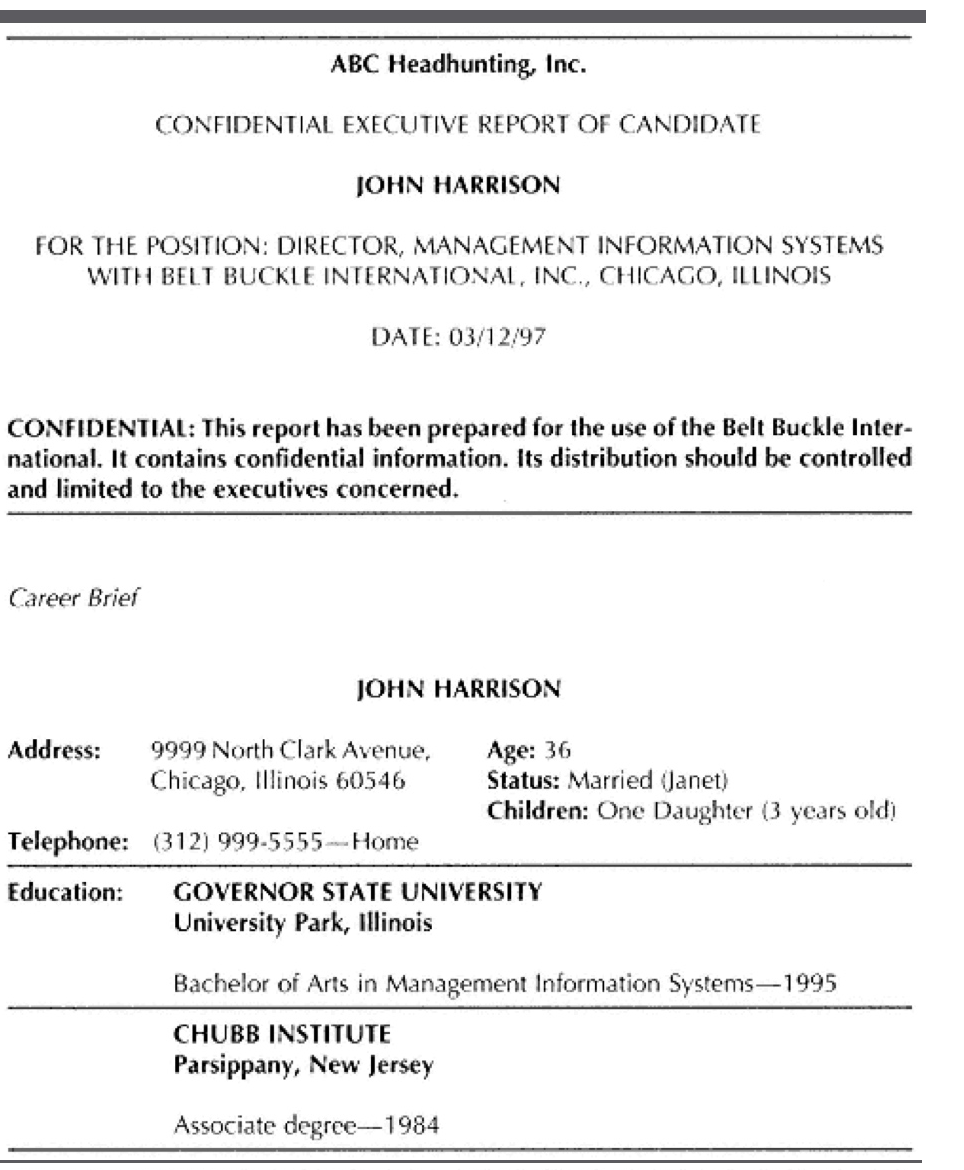
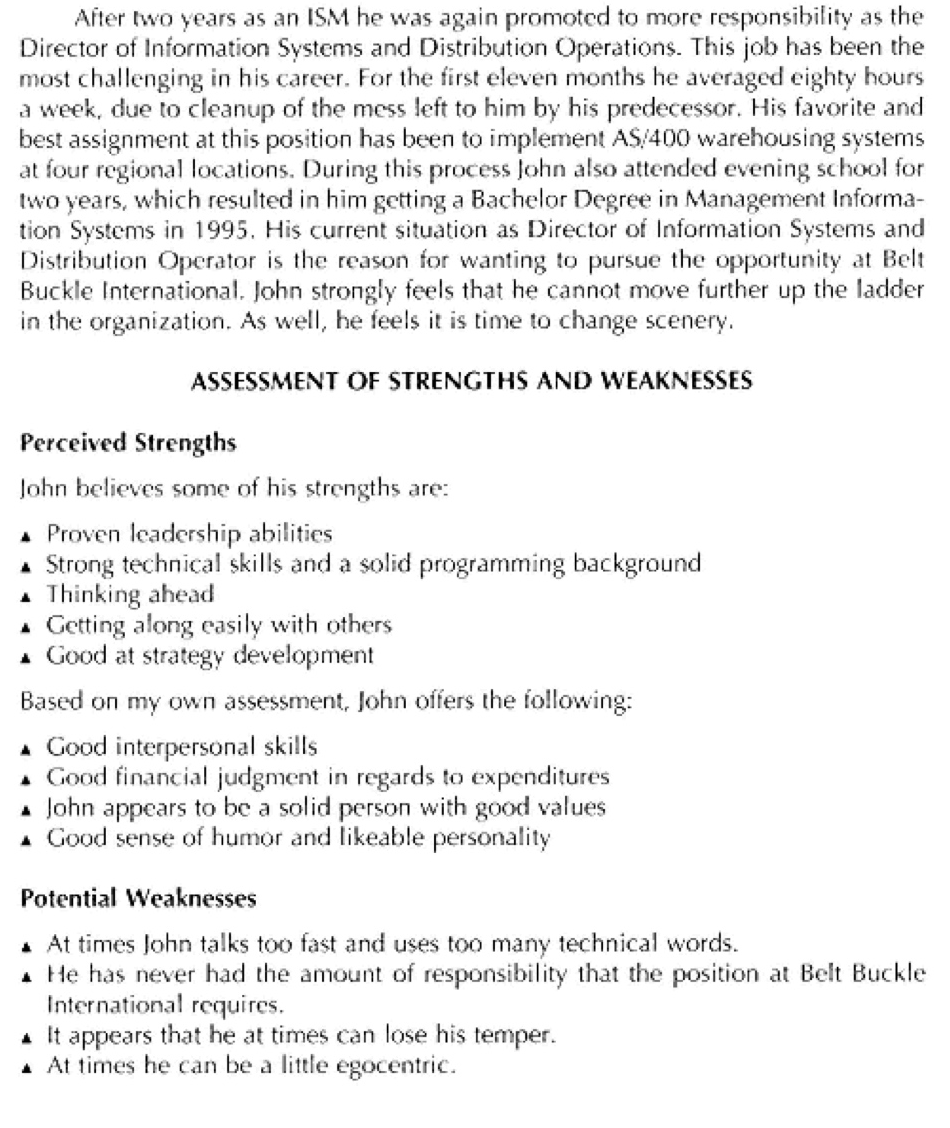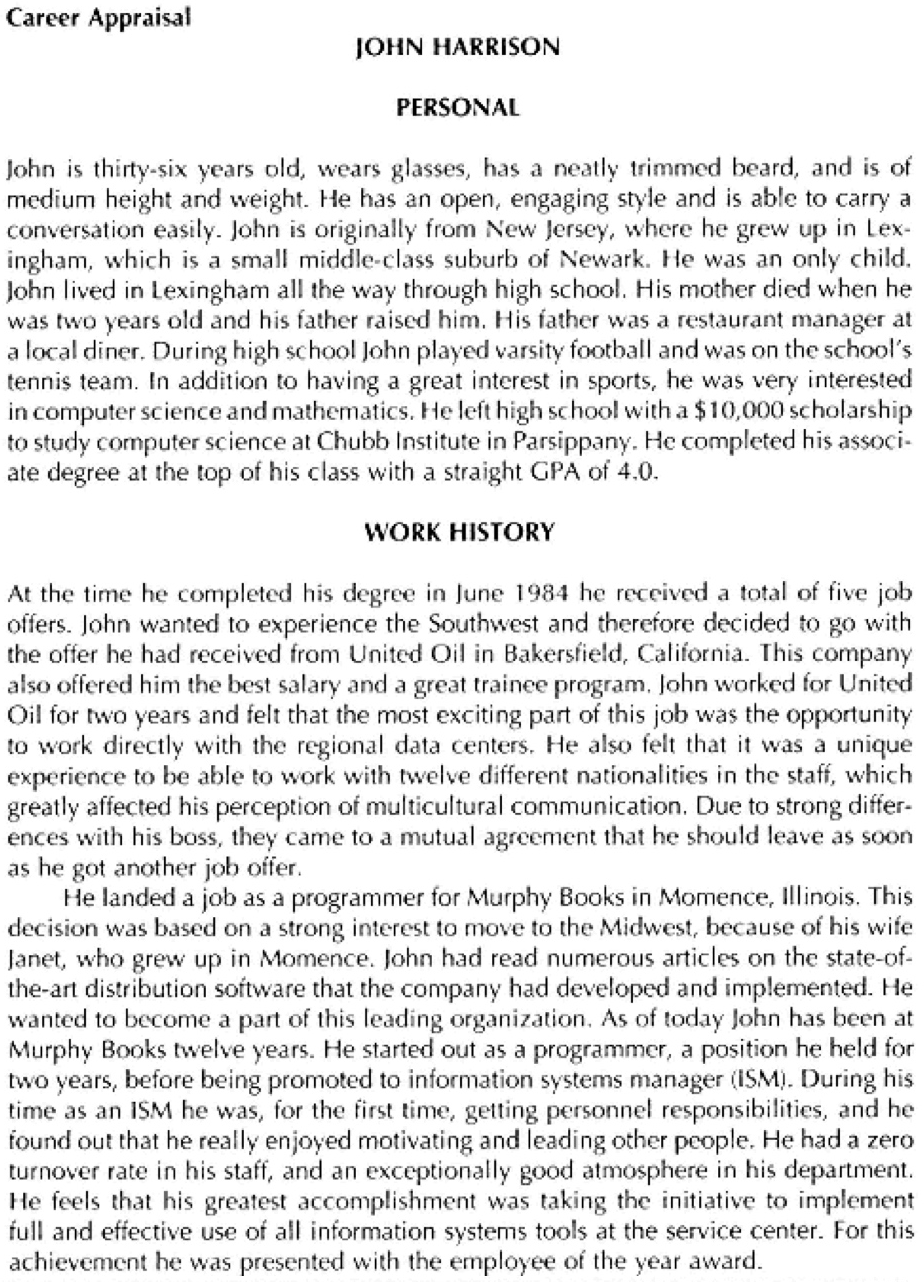
## 5. Reference Checks
In summary a potential candidate is checked in secrecy by:
* Preliminary reference check
* Regular reference check
* Academic claims verified
* Credit
* Criminal record
* News search
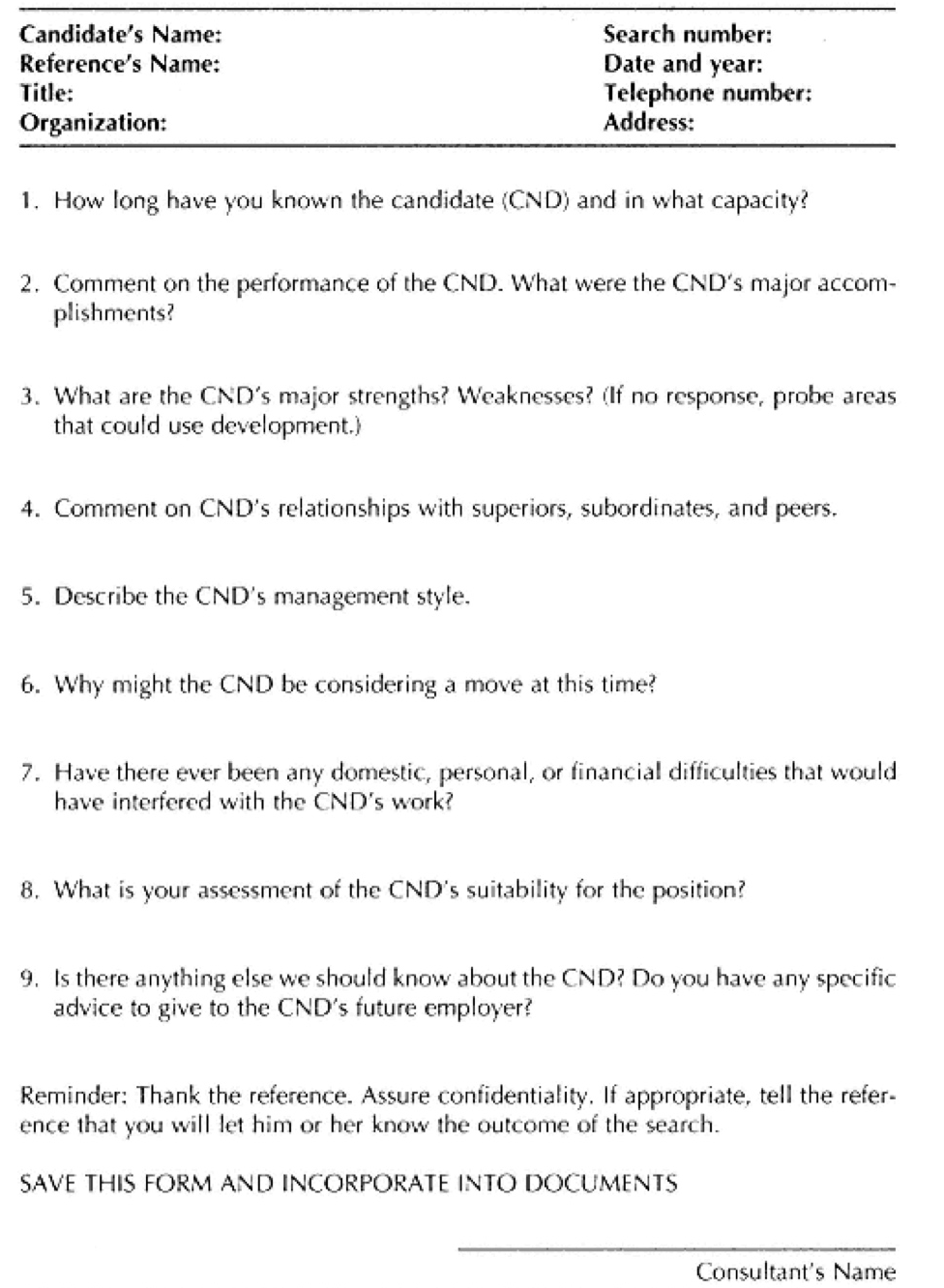
- 0.前言
- 01.文档前言
- 02.致新员工书
- 1.认知体系构建
- 01.互联网背景了解
- 01.社交的逻辑
- 02.移动互联网10年
- 03.互联网的本质是什么-曾鸣
- 04.必读报告
- 05.中国互联网发展20年盘点
- 06.互联网商业发展简史
- 07.互联网信息分发简明史
- 08. 互联网背景音频(大佬)
- 02.典型公司了解:腾讯、头条、阿里等
- 01.互联网公司职级体系
- 02.今日头条:业务、组织
- 04. 阿里、小米、京东、美团:组织、战略
- 05.阿里巴巴2020年Q3财报
- 06.Shopee财报分析
- 07.阿里巴巴商业版图
- 03.VC投资相关
- 01.VC 投资逻辑:风险投资VC基础知识
- 02.风险投资的逻辑体系
- 03.“天使投资、VC、PE”与“A轮、B轮、C轮融资”的关系
- 04.HR相关
- 01.HR+三支柱
- 02.人力资源六大模型
- 05.其他
- 01.阿里、小米、京东、美团战略变迁
- 02.互联网简史-格隆汇
- 03.互联网职能浅析:研发、产品、运营等
- 04.一篇文章搞懂互联网技术、产品、运营人
- 05.什么是top biller?
- 2.职能知识
- 00.视频材料(必修课)
- 01.网站运行原理:新人必读
- 02. 前端知识:前端必读
- 03.电商后台架构:后台必读
- 04. 硅谷大数据应用:数据方向必读
- 05.网易云音乐推荐算法:数据组必读
- 05.大数据平台:数据方向必读
- 06. 3D成像相关
- 07.一文读懂支付
- 08.数据中台
- 09.大厂“中台战略”剖析
- 10.白话中台战略
- 3.行业研究/公司分析
- 01.字节跳动:必读
- 4.猎头相关
- 01.猎头的三种模式
- 02. 18 must-have recruitment skills
- 03.Linkedin 使用
- 04.Linkedin 7 Tips
- 05. Sourcing on Github
- 06. Sourcing on Github 2
- 07. 脉脉使用
- 08. Secrets of the Executive Search Experts
- PART 1. Research Methodology
- PART 2. Interview with the Experts
- 5. 业务提升
- 00.培训综述
- 01. CC框架/技巧
- 02.中小型公司介绍框架
- 03.工作流指南
- 04. 入门视频课程
- 6.行业相关知识点
- 01.区块链-阮一峰
- 7.OKR 2020
- 8.授人渔
- 00.职能知识视频材料
- 01.行业分析报告获取
- 02.阅读书单
- 9.招聘计划
- 10.Keven的内部Blog
- 01.写在开工第一周
- 3,职位说明书编写
